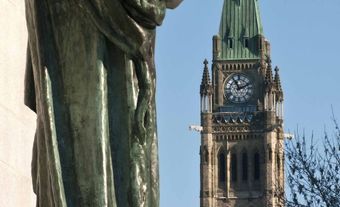Public Administration
Public administration has no generally accepted definition. The scope of the subject is so great and so debatable that it is easier to explain than define. Public administration is both a field of study, or a discipline, and a field of practice, or an occupation. There is much disagreement about whether the study of public administration can properly be called a discipline, largely because it is often viewed as a subfield of the 2 disciplines of POLITICAL SCIENCE and administrative science (or administration).
In Canada the study of public administration has evolved primarily as a subfield of political science. Knowledge of the machinery of government and of the political and legal environment in which public administrators work is essential to understanding the political system. Also, public administrators play an important role by providing policy advice to elected politicians and by active involvement in the making, enforcement and adjudication of laws and regulations. As a subfield of administrative science, public administration is part of the generic process of administration. The broad field of administration is divided into public, business, hospital, educational and other forms of administration. The similarities between these forms of administration are considered to be greater than their differences.
There is, however, increasing recognition of public administration as a separate field of study, which is reflected in the creation within universities of schools of public administration which take a policy-management approach combining elements of the 2 earlier approaches with an examination of PUBLIC POLICY. Public administration is taught as an interdisciplinary subject by political scientists, economists, sociologists and others.
No single date or event clearly marks the beginning of the study of public administration in Canada. The multivolume work CANADA AND ITS PROVINCES (1913-17) by A. Shortt and A.G. Doughty covered the practice of public administration, and several books written by R. MacGregor DAWSON between 1919 and 1933 made an enduring contribution to the field. The first degree program in public administration was established at Dalhousie University by Luther Richter and R.A. Mackay in 1936. Carleton College (now Carleton University) had its first graduates in 1946, and in 1952 founded its School of Public Administration. There are now schools or faculties of public administration at several universities across Canada; the oldest and largest of these include Queen's, the University of Victoria and the École nationale d'administration publique (Québec). Beginning in the early 1950s, significant contributions to the literature on Canadian public administration were made by such prominent scholars as Roch Bolduc, J.E. HODGETTS, J.R. Mallory, D.C. Rowat and Malcolm Taylor.
Public administration is a relatively new but vigorous and important field of study. The increasing number of people who study it are - or would like to be - employed by a federal, provincial or municipal government. Even public employees who are trained in law, engineering, medicine, etc, often study public administration to help them understand and perform management tasks. Job opportunities exist in regular government departments and in government agencies, boards and commissions. If the scope of public administration is broadly defined, it also includes such occupational categories as hospital and educational administration.
Among the many fields of work in public administration are the broad areas of personnel management, financial management, regulation and policy analysis. The major institution or society in the field of public administration is the Institute of Public Administration of Canada, a national organization and a learned society of public employees from all levels of government and university teachers. It sponsors seminars, conferences and publications, including the journal Canadian Public Administration.

 Share on Facebook
Share on Facebook Share on X
Share on X Share by Email
Share by Email Share on Google Classroom
Share on Google Classroom


